Business Analytics in Manufacturing Sector - PDF
VerifiedAdded on 2021/06/17
|12
|3426
|76
AI Summary
Contribute Materials
Your contribution can guide someone’s learning journey. Share your
documents today.
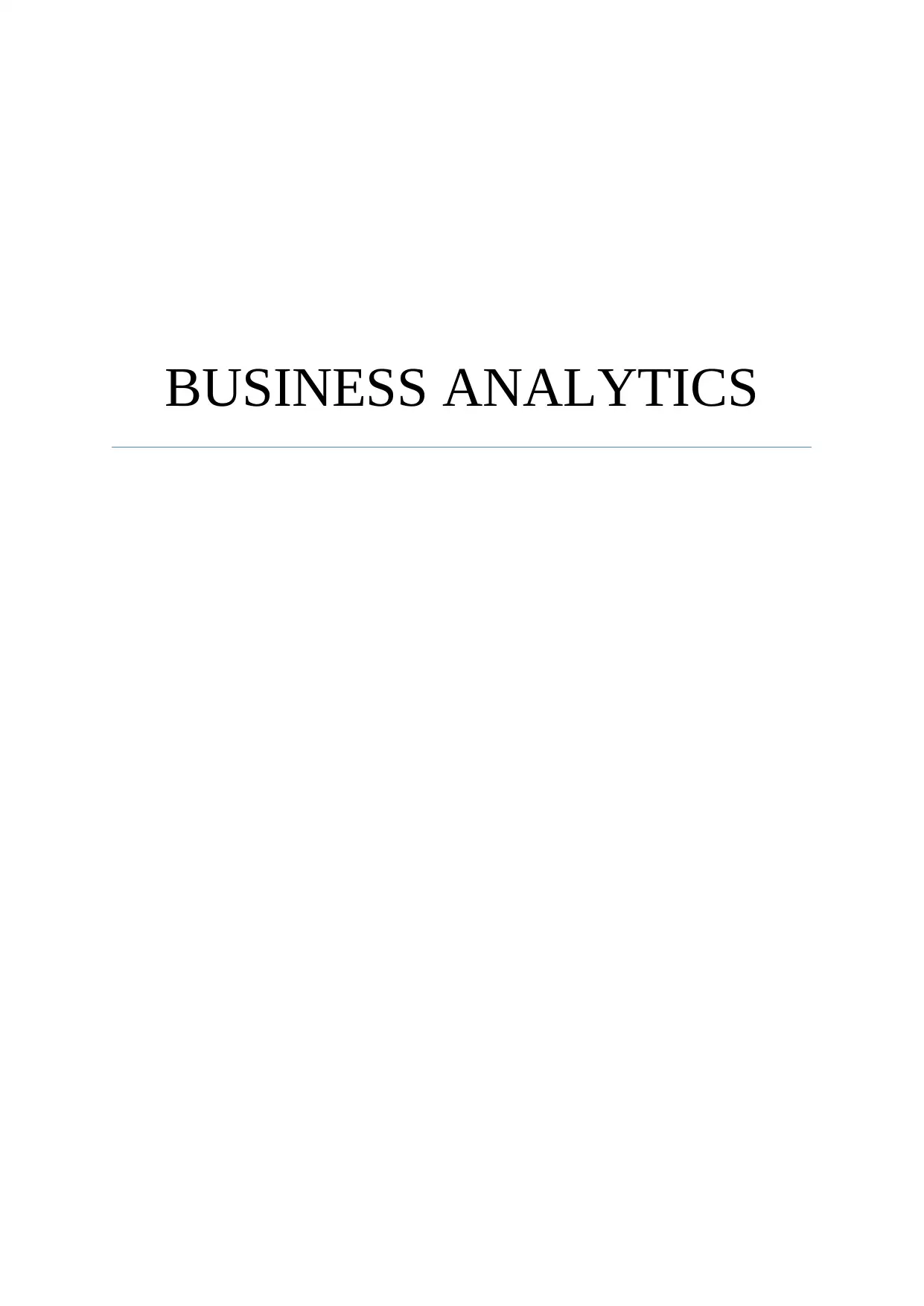
BUSINESS ANALYTICS
Secure Best Marks with AI Grader
Need help grading? Try our AI Grader for instant feedback on your assignments.

1
EXECUTIVE SUMMARY
Business analytics is considered as the future of the companies in various industries. Almost
all the industries have adopted business analytics as their tool along with the manufacturing
industry. This report revolves around the use of business analytics in the manufacturing
sector. There are several drivers of BA adoption which has been described in the report. In
the later part of the report perceived and obtained benefits of using BA has been elaborated.
Data driven BA strategy that is adopted by the manufacturing companies can be beneficial for
them. In the last part of this report the drawbacks linked with data driven BA strategy has
been showcased along with the recommendation that could help the firms in making their
business analytics more appropriate and effective.
EXECUTIVE SUMMARY
Business analytics is considered as the future of the companies in various industries. Almost
all the industries have adopted business analytics as their tool along with the manufacturing
industry. This report revolves around the use of business analytics in the manufacturing
sector. There are several drivers of BA adoption which has been described in the report. In
the later part of the report perceived and obtained benefits of using BA has been elaborated.
Data driven BA strategy that is adopted by the manufacturing companies can be beneficial for
them. In the last part of this report the drawbacks linked with data driven BA strategy has
been showcased along with the recommendation that could help the firms in making their
business analytics more appropriate and effective.
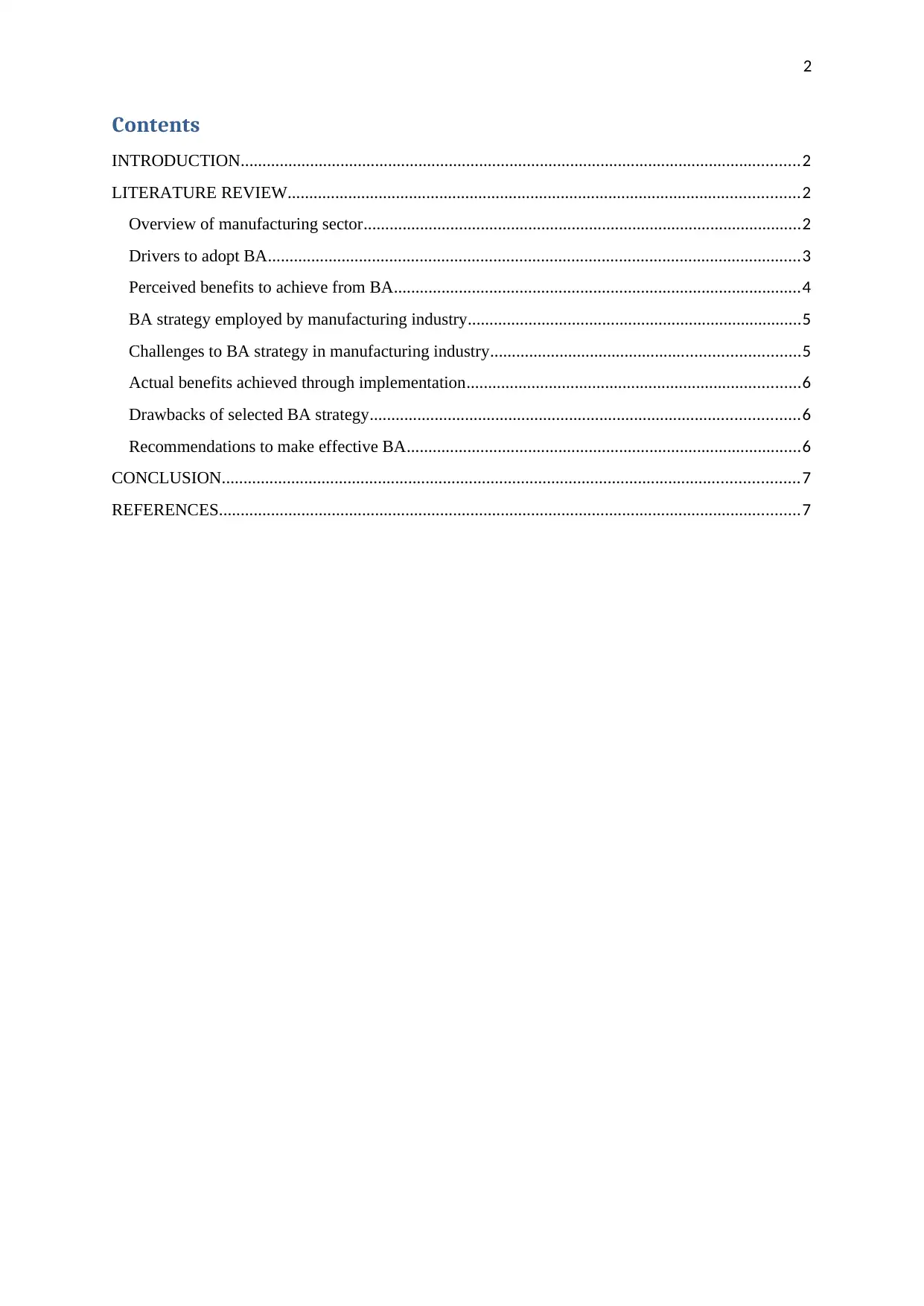
2
Contents
INTRODUCTION.................................................................................................................................2
LITERATURE REVIEW......................................................................................................................2
Overview of manufacturing sector.....................................................................................................2
Drivers to adopt BA...........................................................................................................................3
Perceived benefits to achieve from BA..............................................................................................4
BA strategy employed by manufacturing industry.............................................................................5
Challenges to BA strategy in manufacturing industry.......................................................................5
Actual benefits achieved through implementation.............................................................................6
Drawbacks of selected BA strategy...................................................................................................6
Recommendations to make effective BA...........................................................................................6
CONCLUSION.....................................................................................................................................7
REFERENCES......................................................................................................................................7
Contents
INTRODUCTION.................................................................................................................................2
LITERATURE REVIEW......................................................................................................................2
Overview of manufacturing sector.....................................................................................................2
Drivers to adopt BA...........................................................................................................................3
Perceived benefits to achieve from BA..............................................................................................4
BA strategy employed by manufacturing industry.............................................................................5
Challenges to BA strategy in manufacturing industry.......................................................................5
Actual benefits achieved through implementation.............................................................................6
Drawbacks of selected BA strategy...................................................................................................6
Recommendations to make effective BA...........................................................................................6
CONCLUSION.....................................................................................................................................7
REFERENCES......................................................................................................................................7
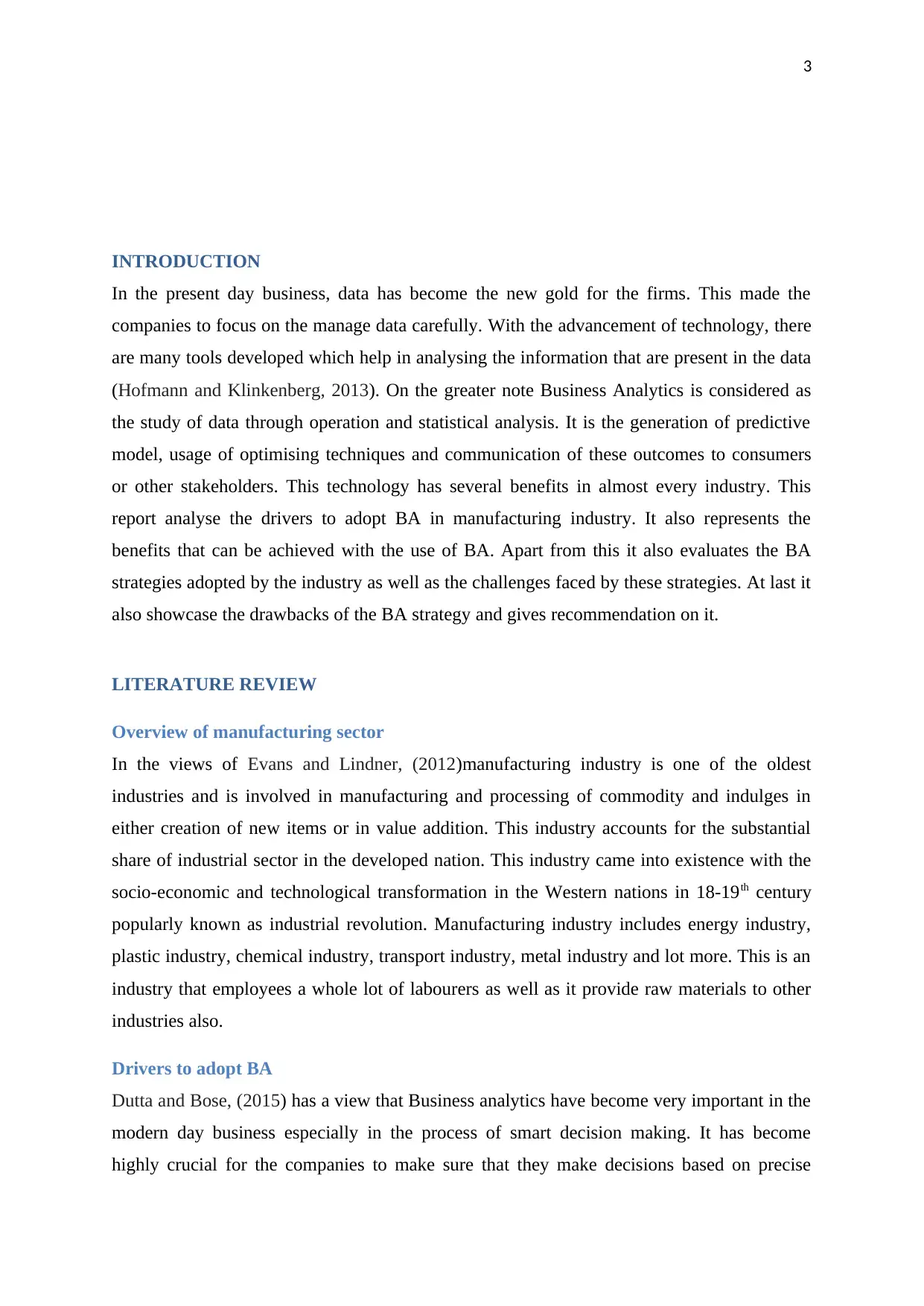
3
INTRODUCTION
In the present day business, data has become the new gold for the firms. This made the
companies to focus on the manage data carefully. With the advancement of technology, there
are many tools developed which help in analysing the information that are present in the data
(Hofmann and Klinkenberg, 2013). On the greater note Business Analytics is considered as
the study of data through operation and statistical analysis. It is the generation of predictive
model, usage of optimising techniques and communication of these outcomes to consumers
or other stakeholders. This technology has several benefits in almost every industry. This
report analyse the drivers to adopt BA in manufacturing industry. It also represents the
benefits that can be achieved with the use of BA. Apart from this it also evaluates the BA
strategies adopted by the industry as well as the challenges faced by these strategies. At last it
also showcase the drawbacks of the BA strategy and gives recommendation on it.
LITERATURE REVIEW
Overview of manufacturing sector
In the views of Evans and Lindner, (2012)manufacturing industry is one of the oldest
industries and is involved in manufacturing and processing of commodity and indulges in
either creation of new items or in value addition. This industry accounts for the substantial
share of industrial sector in the developed nation. This industry came into existence with the
socio-economic and technological transformation in the Western nations in 18-19th century
popularly known as industrial revolution. Manufacturing industry includes energy industry,
plastic industry, chemical industry, transport industry, metal industry and lot more. This is an
industry that employees a whole lot of labourers as well as it provide raw materials to other
industries also.
Drivers to adopt BA
Dutta and Bose, (2015) has a view that Business analytics have become very important in the
modern day business especially in the process of smart decision making. It has become
highly crucial for the companies to make sure that they make decisions based on precise
INTRODUCTION
In the present day business, data has become the new gold for the firms. This made the
companies to focus on the manage data carefully. With the advancement of technology, there
are many tools developed which help in analysing the information that are present in the data
(Hofmann and Klinkenberg, 2013). On the greater note Business Analytics is considered as
the study of data through operation and statistical analysis. It is the generation of predictive
model, usage of optimising techniques and communication of these outcomes to consumers
or other stakeholders. This technology has several benefits in almost every industry. This
report analyse the drivers to adopt BA in manufacturing industry. It also represents the
benefits that can be achieved with the use of BA. Apart from this it also evaluates the BA
strategies adopted by the industry as well as the challenges faced by these strategies. At last it
also showcase the drawbacks of the BA strategy and gives recommendation on it.
LITERATURE REVIEW
Overview of manufacturing sector
In the views of Evans and Lindner, (2012)manufacturing industry is one of the oldest
industries and is involved in manufacturing and processing of commodity and indulges in
either creation of new items or in value addition. This industry accounts for the substantial
share of industrial sector in the developed nation. This industry came into existence with the
socio-economic and technological transformation in the Western nations in 18-19th century
popularly known as industrial revolution. Manufacturing industry includes energy industry,
plastic industry, chemical industry, transport industry, metal industry and lot more. This is an
industry that employees a whole lot of labourers as well as it provide raw materials to other
industries also.
Drivers to adopt BA
Dutta and Bose, (2015) has a view that Business analytics have become very important in the
modern day business especially in the process of smart decision making. It has become
highly crucial for the companies to make sure that they make decisions based on precise
Secure Best Marks with AI Grader
Need help grading? Try our AI Grader for instant feedback on your assignments.
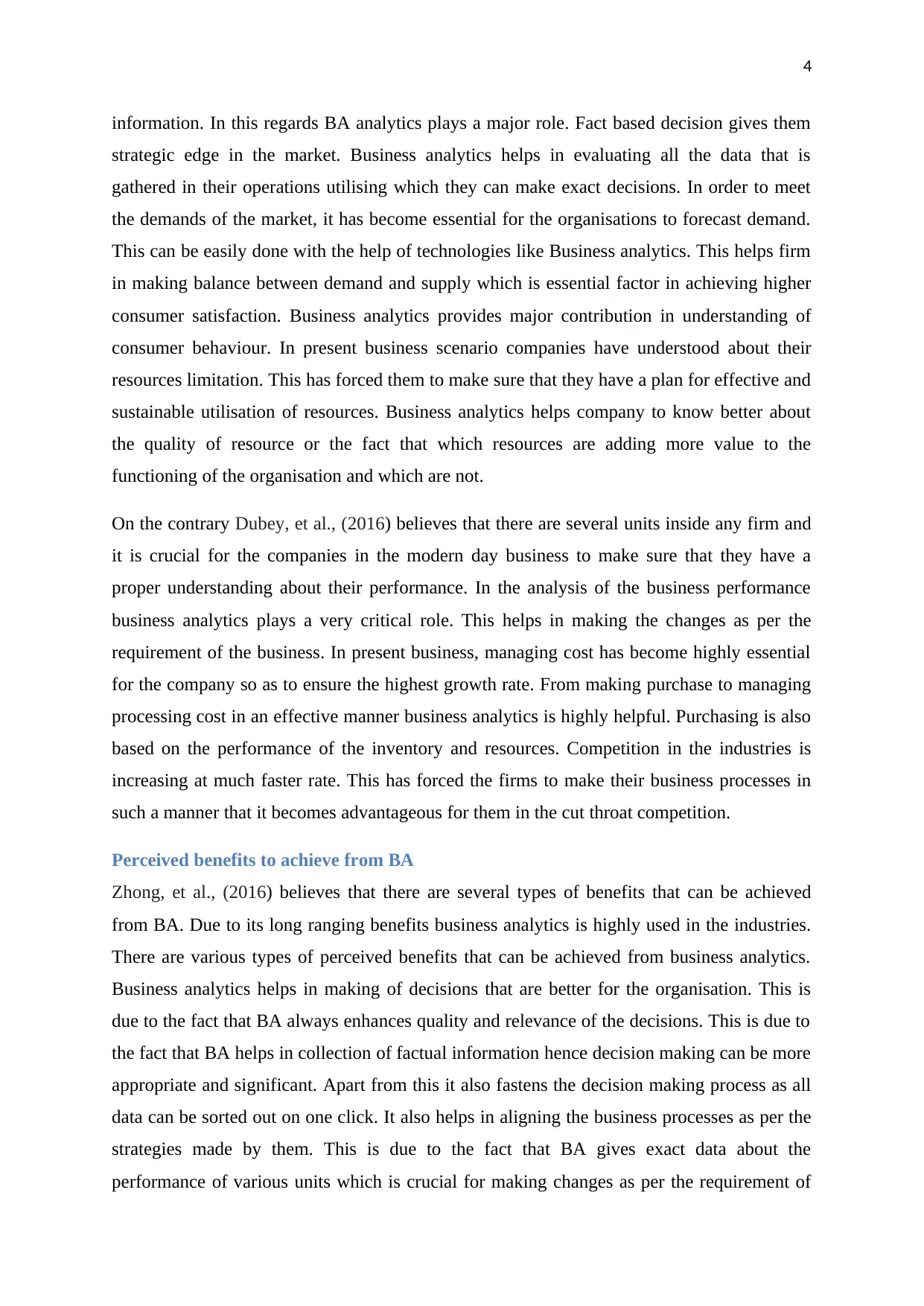
4
information. In this regards BA analytics plays a major role. Fact based decision gives them
strategic edge in the market. Business analytics helps in evaluating all the data that is
gathered in their operations utilising which they can make exact decisions. In order to meet
the demands of the market, it has become essential for the organisations to forecast demand.
This can be easily done with the help of technologies like Business analytics. This helps firm
in making balance between demand and supply which is essential factor in achieving higher
consumer satisfaction. Business analytics provides major contribution in understanding of
consumer behaviour. In present business scenario companies have understood about their
resources limitation. This has forced them to make sure that they have a plan for effective and
sustainable utilisation of resources. Business analytics helps company to know better about
the quality of resource or the fact that which resources are adding more value to the
functioning of the organisation and which are not.
On the contrary Dubey, et al., (2016) believes that there are several units inside any firm and
it is crucial for the companies in the modern day business to make sure that they have a
proper understanding about their performance. In the analysis of the business performance
business analytics plays a very critical role. This helps in making the changes as per the
requirement of the business. In present business, managing cost has become highly essential
for the company so as to ensure the highest growth rate. From making purchase to managing
processing cost in an effective manner business analytics is highly helpful. Purchasing is also
based on the performance of the inventory and resources. Competition in the industries is
increasing at much faster rate. This has forced the firms to make their business processes in
such a manner that it becomes advantageous for them in the cut throat competition.
Perceived benefits to achieve from BA
Zhong, et al., (2016) believes that there are several types of benefits that can be achieved
from BA. Due to its long ranging benefits business analytics is highly used in the industries.
There are various types of perceived benefits that can be achieved from business analytics.
Business analytics helps in making of decisions that are better for the organisation. This is
due to the fact that BA always enhances quality and relevance of the decisions. This is due to
the fact that BA helps in collection of factual information hence decision making can be more
appropriate and significant. Apart from this it also fastens the decision making process as all
data can be sorted out on one click. It also helps in aligning the business processes as per the
strategies made by them. This is due to the fact that BA gives exact data about the
performance of various units which is crucial for making changes as per the requirement of
information. In this regards BA analytics plays a major role. Fact based decision gives them
strategic edge in the market. Business analytics helps in evaluating all the data that is
gathered in their operations utilising which they can make exact decisions. In order to meet
the demands of the market, it has become essential for the organisations to forecast demand.
This can be easily done with the help of technologies like Business analytics. This helps firm
in making balance between demand and supply which is essential factor in achieving higher
consumer satisfaction. Business analytics provides major contribution in understanding of
consumer behaviour. In present business scenario companies have understood about their
resources limitation. This has forced them to make sure that they have a plan for effective and
sustainable utilisation of resources. Business analytics helps company to know better about
the quality of resource or the fact that which resources are adding more value to the
functioning of the organisation and which are not.
On the contrary Dubey, et al., (2016) believes that there are several units inside any firm and
it is crucial for the companies in the modern day business to make sure that they have a
proper understanding about their performance. In the analysis of the business performance
business analytics plays a very critical role. This helps in making the changes as per the
requirement of the business. In present business, managing cost has become highly essential
for the company so as to ensure the highest growth rate. From making purchase to managing
processing cost in an effective manner business analytics is highly helpful. Purchasing is also
based on the performance of the inventory and resources. Competition in the industries is
increasing at much faster rate. This has forced the firms to make their business processes in
such a manner that it becomes advantageous for them in the cut throat competition.
Perceived benefits to achieve from BA
Zhong, et al., (2016) believes that there are several types of benefits that can be achieved
from BA. Due to its long ranging benefits business analytics is highly used in the industries.
There are various types of perceived benefits that can be achieved from business analytics.
Business analytics helps in making of decisions that are better for the organisation. This is
due to the fact that BA always enhances quality and relevance of the decisions. This is due to
the fact that BA helps in collection of factual information hence decision making can be more
appropriate and significant. Apart from this it also fastens the decision making process as all
data can be sorted out on one click. It also helps in aligning the business processes as per the
strategies made by them. This is due to the fact that BA gives exact data about the
performance of various units which is crucial for making changes as per the requirement of

5
strategies made by the company. BA gives the idea about the factors and variables that is
diverging the path of the company from its made strategies. It helps in managing the cost
related efficiencies. There are several kinds of cost involved in the operations of the firm.
Business analytical assists in realising the things that can be done so as to make cost efficient
operations.
Kasemsap, (2015) states that business analytics helps the firms in manufacturing and other
sector to respond to the demands of the market. It not helps in availing the data but it also
helps in availing it on time otherwise the data will be of no importance. Today trends and
various factors are changing at much faster rate this makes it more essential for a company to
have business analytics so as to be updated with slightest of changes in the operations. Since
the business analytics helps in making of the decisions that gives them competitive edge over
the competitors. All the values that BA adds to the business ultimately improve the
competitiveness of the firms which is necessary for the survival and growth of the company.
BA helps in making of the decisions that are more their capability based and hence there is a
less chance that they face failures. It has become essential for the firm to make sure that they
have a single and unified view towards the information that is collected in their operations. It
generally generates information as per the requirement of different units within
manufacturing sector. There are several operations inside the firm that needs to be
synchronised especially the things that are related with the operational strategy or financial
strategy. Synchronising helps the firm in aligning all the operations in one unit so as to
achieve the desired outcomes. Since business analytics helps in many ways hence gets
ultimately reflected at revenue of the firm. Its effect is positive on the revenue generation of
the company. This will help the firm in sharing information among all the stakeholders at
same time. Any authenticated person can retrieved crucial information from the system as per
their requirement hence BA acts as a tool for sharing information.
BA strategy employed by manufacturing industry
In the view point of Minelli, Chambers and Dhiraj, (2012) there are several business analytics
strategies that are employed by the manufacturing industry. This helps them in making their
operations more fruitful and result oriented. In the manufacturing industry, there are several
types of data obtained from various sources. Firms in this industry must engage with internal
clients. Apart from this company must audit the analytics tools and report catalogue, overload
and clean duplication. Company should also monitor business vitals for making dashboard
strategies made by the company. BA gives the idea about the factors and variables that is
diverging the path of the company from its made strategies. It helps in managing the cost
related efficiencies. There are several kinds of cost involved in the operations of the firm.
Business analytical assists in realising the things that can be done so as to make cost efficient
operations.
Kasemsap, (2015) states that business analytics helps the firms in manufacturing and other
sector to respond to the demands of the market. It not helps in availing the data but it also
helps in availing it on time otherwise the data will be of no importance. Today trends and
various factors are changing at much faster rate this makes it more essential for a company to
have business analytics so as to be updated with slightest of changes in the operations. Since
the business analytics helps in making of the decisions that gives them competitive edge over
the competitors. All the values that BA adds to the business ultimately improve the
competitiveness of the firms which is necessary for the survival and growth of the company.
BA helps in making of the decisions that are more their capability based and hence there is a
less chance that they face failures. It has become essential for the firm to make sure that they
have a single and unified view towards the information that is collected in their operations. It
generally generates information as per the requirement of different units within
manufacturing sector. There are several operations inside the firm that needs to be
synchronised especially the things that are related with the operational strategy or financial
strategy. Synchronising helps the firm in aligning all the operations in one unit so as to
achieve the desired outcomes. Since business analytics helps in many ways hence gets
ultimately reflected at revenue of the firm. Its effect is positive on the revenue generation of
the company. This will help the firm in sharing information among all the stakeholders at
same time. Any authenticated person can retrieved crucial information from the system as per
their requirement hence BA acts as a tool for sharing information.
BA strategy employed by manufacturing industry
In the view point of Minelli, Chambers and Dhiraj, (2012) there are several business analytics
strategies that are employed by the manufacturing industry. This helps them in making their
operations more fruitful and result oriented. In the manufacturing industry, there are several
types of data obtained from various sources. Firms in this industry must engage with internal
clients. Apart from this company must audit the analytics tools and report catalogue, overload
and clean duplication. Company should also monitor business vitals for making dashboard
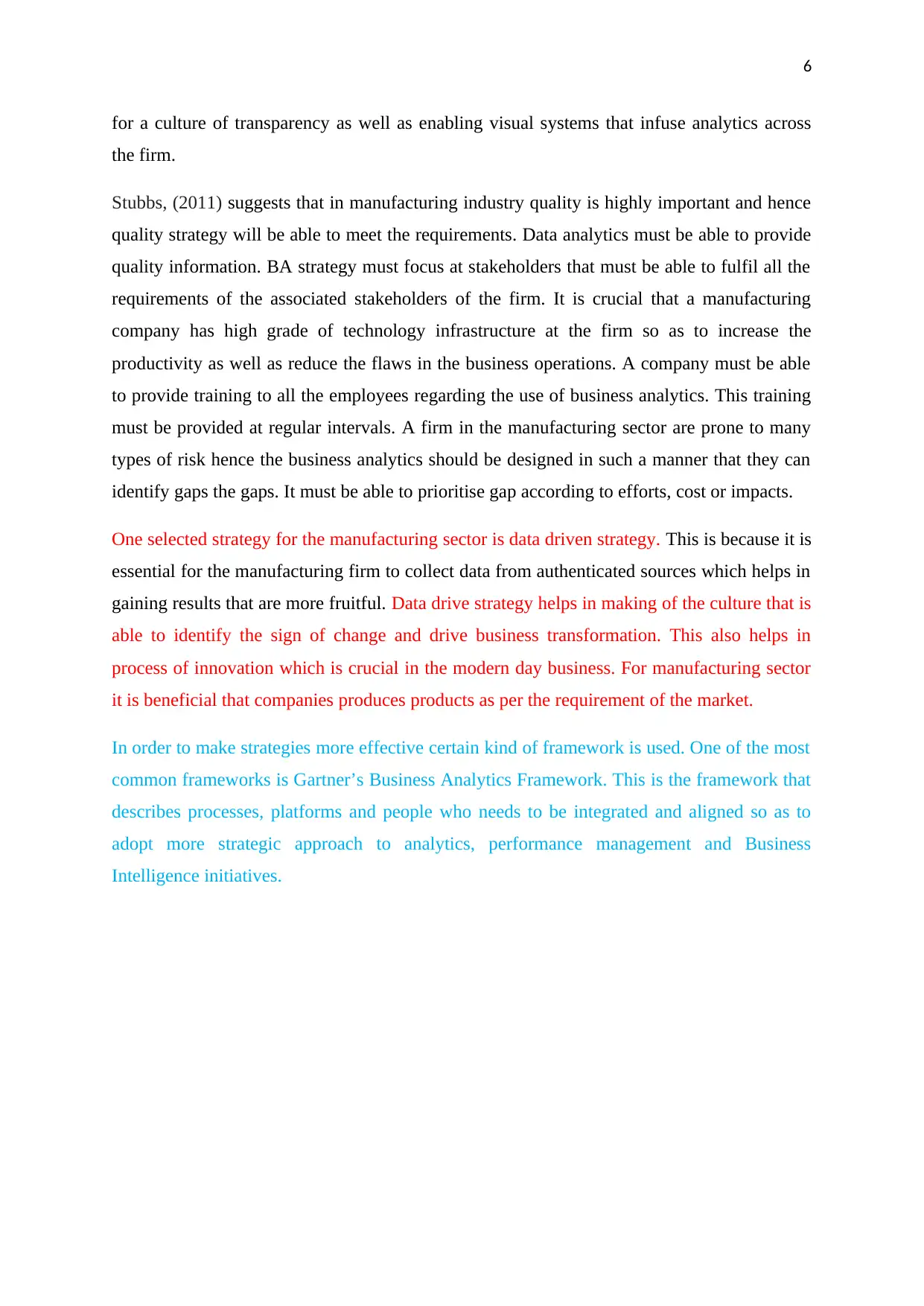
6
for a culture of transparency as well as enabling visual systems that infuse analytics across
the firm.
Stubbs, (2011) suggests that in manufacturing industry quality is highly important and hence
quality strategy will be able to meet the requirements. Data analytics must be able to provide
quality information. BA strategy must focus at stakeholders that must be able to fulfil all the
requirements of the associated stakeholders of the firm. It is crucial that a manufacturing
company has high grade of technology infrastructure at the firm so as to increase the
productivity as well as reduce the flaws in the business operations. A company must be able
to provide training to all the employees regarding the use of business analytics. This training
must be provided at regular intervals. A firm in the manufacturing sector are prone to many
types of risk hence the business analytics should be designed in such a manner that they can
identify gaps the gaps. It must be able to prioritise gap according to efforts, cost or impacts.
One selected strategy for the manufacturing sector is data driven strategy. This is because it is
essential for the manufacturing firm to collect data from authenticated sources which helps in
gaining results that are more fruitful. Data drive strategy helps in making of the culture that is
able to identify the sign of change and drive business transformation. This also helps in
process of innovation which is crucial in the modern day business. For manufacturing sector
it is beneficial that companies produces products as per the requirement of the market.
In order to make strategies more effective certain kind of framework is used. One of the most
common frameworks is Gartner’s Business Analytics Framework. This is the framework that
describes processes, platforms and people who needs to be integrated and aligned so as to
adopt more strategic approach to analytics, performance management and Business
Intelligence initiatives.
for a culture of transparency as well as enabling visual systems that infuse analytics across
the firm.
Stubbs, (2011) suggests that in manufacturing industry quality is highly important and hence
quality strategy will be able to meet the requirements. Data analytics must be able to provide
quality information. BA strategy must focus at stakeholders that must be able to fulfil all the
requirements of the associated stakeholders of the firm. It is crucial that a manufacturing
company has high grade of technology infrastructure at the firm so as to increase the
productivity as well as reduce the flaws in the business operations. A company must be able
to provide training to all the employees regarding the use of business analytics. This training
must be provided at regular intervals. A firm in the manufacturing sector are prone to many
types of risk hence the business analytics should be designed in such a manner that they can
identify gaps the gaps. It must be able to prioritise gap according to efforts, cost or impacts.
One selected strategy for the manufacturing sector is data driven strategy. This is because it is
essential for the manufacturing firm to collect data from authenticated sources which helps in
gaining results that are more fruitful. Data drive strategy helps in making of the culture that is
able to identify the sign of change and drive business transformation. This also helps in
process of innovation which is crucial in the modern day business. For manufacturing sector
it is beneficial that companies produces products as per the requirement of the market.
In order to make strategies more effective certain kind of framework is used. One of the most
common frameworks is Gartner’s Business Analytics Framework. This is the framework that
describes processes, platforms and people who needs to be integrated and aligned so as to
adopt more strategic approach to analytics, performance management and Business
Intelligence initiatives.
Paraphrase This Document
Need a fresh take? Get an instant paraphrase of this document with our AI Paraphraser
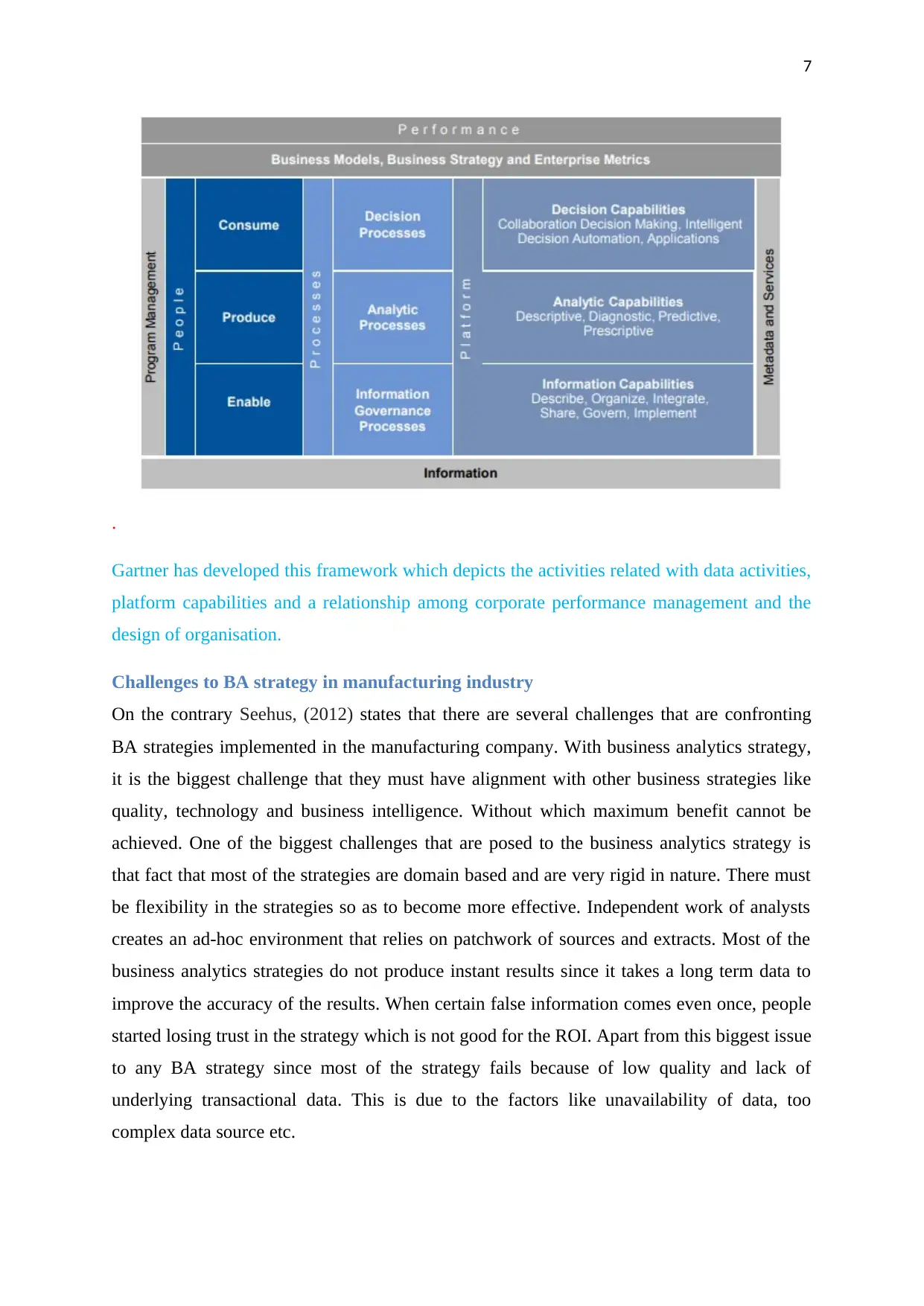
7
.
Gartner has developed this framework which depicts the activities related with data activities,
platform capabilities and a relationship among corporate performance management and the
design of organisation.
Challenges to BA strategy in manufacturing industry
On the contrary Seehus, (2012) states that there are several challenges that are confronting
BA strategies implemented in the manufacturing company. With business analytics strategy,
it is the biggest challenge that they must have alignment with other business strategies like
quality, technology and business intelligence. Without which maximum benefit cannot be
achieved. One of the biggest challenges that are posed to the business analytics strategy is
that fact that most of the strategies are domain based and are very rigid in nature. There must
be flexibility in the strategies so as to become more effective. Independent work of analysts
creates an ad-hoc environment that relies on patchwork of sources and extracts. Most of the
business analytics strategies do not produce instant results since it takes a long term data to
improve the accuracy of the results. When certain false information comes even once, people
started losing trust in the strategy which is not good for the ROI. Apart from this biggest issue
to any BA strategy since most of the strategy fails because of low quality and lack of
underlying transactional data. This is due to the factors like unavailability of data, too
complex data source etc.
.
Gartner has developed this framework which depicts the activities related with data activities,
platform capabilities and a relationship among corporate performance management and the
design of organisation.
Challenges to BA strategy in manufacturing industry
On the contrary Seehus, (2012) states that there are several challenges that are confronting
BA strategies implemented in the manufacturing company. With business analytics strategy,
it is the biggest challenge that they must have alignment with other business strategies like
quality, technology and business intelligence. Without which maximum benefit cannot be
achieved. One of the biggest challenges that are posed to the business analytics strategy is
that fact that most of the strategies are domain based and are very rigid in nature. There must
be flexibility in the strategies so as to become more effective. Independent work of analysts
creates an ad-hoc environment that relies on patchwork of sources and extracts. Most of the
business analytics strategies do not produce instant results since it takes a long term data to
improve the accuracy of the results. When certain false information comes even once, people
started losing trust in the strategy which is not good for the ROI. Apart from this biggest issue
to any BA strategy since most of the strategy fails because of low quality and lack of
underlying transactional data. This is due to the factors like unavailability of data, too
complex data source etc.
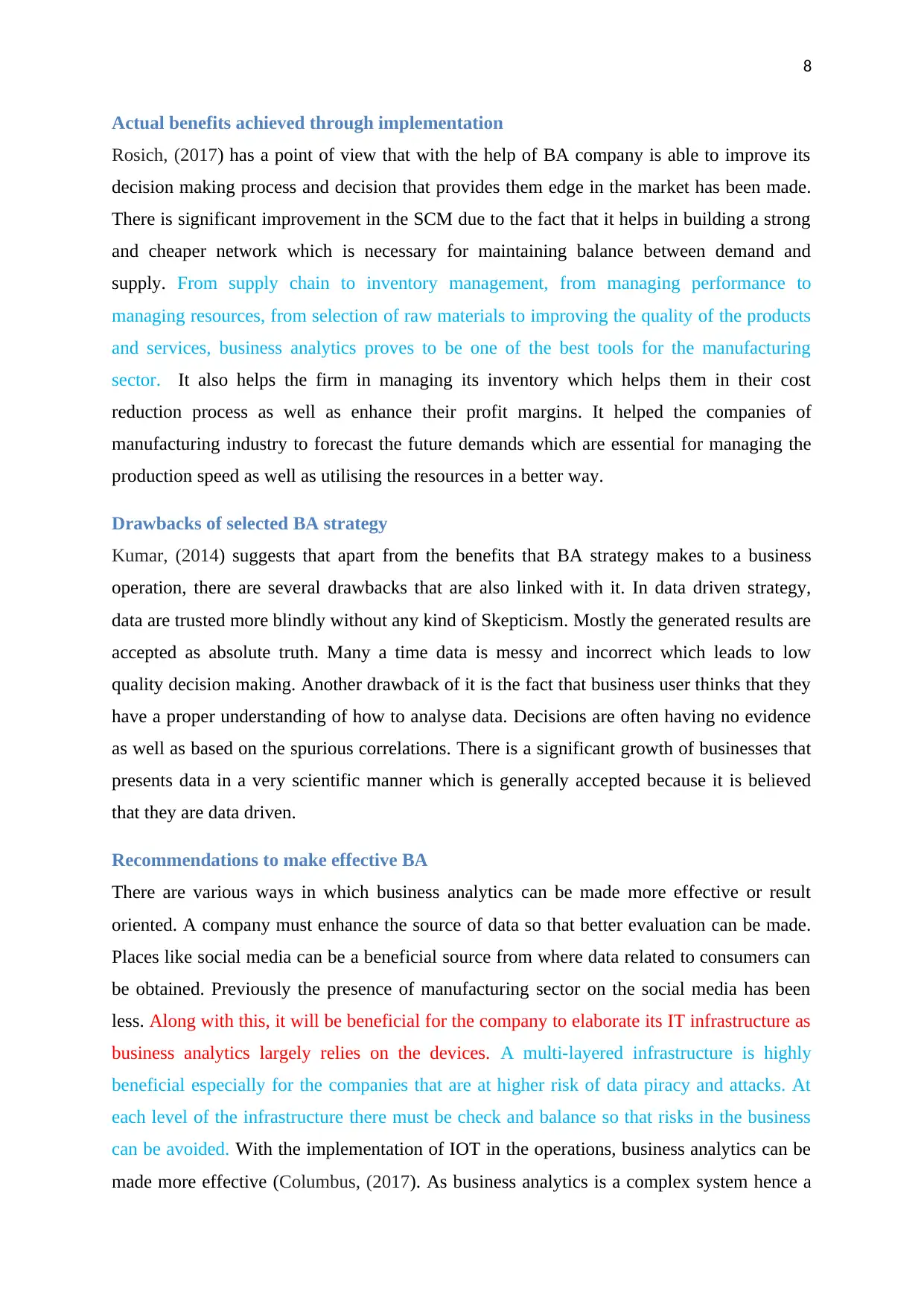
8
Actual benefits achieved through implementation
Rosich, (2017) has a point of view that with the help of BA company is able to improve its
decision making process and decision that provides them edge in the market has been made.
There is significant improvement in the SCM due to the fact that it helps in building a strong
and cheaper network which is necessary for maintaining balance between demand and
supply. From supply chain to inventory management, from managing performance to
managing resources, from selection of raw materials to improving the quality of the products
and services, business analytics proves to be one of the best tools for the manufacturing
sector. It also helps the firm in managing its inventory which helps them in their cost
reduction process as well as enhance their profit margins. It helped the companies of
manufacturing industry to forecast the future demands which are essential for managing the
production speed as well as utilising the resources in a better way.
Drawbacks of selected BA strategy
Kumar, (2014) suggests that apart from the benefits that BA strategy makes to a business
operation, there are several drawbacks that are also linked with it. In data driven strategy,
data are trusted more blindly without any kind of Skepticism. Mostly the generated results are
accepted as absolute truth. Many a time data is messy and incorrect which leads to low
quality decision making. Another drawback of it is the fact that business user thinks that they
have a proper understanding of how to analyse data. Decisions are often having no evidence
as well as based on the spurious correlations. There is a significant growth of businesses that
presents data in a very scientific manner which is generally accepted because it is believed
that they are data driven.
Recommendations to make effective BA
There are various ways in which business analytics can be made more effective or result
oriented. A company must enhance the source of data so that better evaluation can be made.
Places like social media can be a beneficial source from where data related to consumers can
be obtained. Previously the presence of manufacturing sector on the social media has been
less. Along with this, it will be beneficial for the company to elaborate its IT infrastructure as
business analytics largely relies on the devices. A multi-layered infrastructure is highly
beneficial especially for the companies that are at higher risk of data piracy and attacks. At
each level of the infrastructure there must be check and balance so that risks in the business
can be avoided. With the implementation of IOT in the operations, business analytics can be
made more effective (Columbus, (2017). As business analytics is a complex system hence a
Actual benefits achieved through implementation
Rosich, (2017) has a point of view that with the help of BA company is able to improve its
decision making process and decision that provides them edge in the market has been made.
There is significant improvement in the SCM due to the fact that it helps in building a strong
and cheaper network which is necessary for maintaining balance between demand and
supply. From supply chain to inventory management, from managing performance to
managing resources, from selection of raw materials to improving the quality of the products
and services, business analytics proves to be one of the best tools for the manufacturing
sector. It also helps the firm in managing its inventory which helps them in their cost
reduction process as well as enhance their profit margins. It helped the companies of
manufacturing industry to forecast the future demands which are essential for managing the
production speed as well as utilising the resources in a better way.
Drawbacks of selected BA strategy
Kumar, (2014) suggests that apart from the benefits that BA strategy makes to a business
operation, there are several drawbacks that are also linked with it. In data driven strategy,
data are trusted more blindly without any kind of Skepticism. Mostly the generated results are
accepted as absolute truth. Many a time data is messy and incorrect which leads to low
quality decision making. Another drawback of it is the fact that business user thinks that they
have a proper understanding of how to analyse data. Decisions are often having no evidence
as well as based on the spurious correlations. There is a significant growth of businesses that
presents data in a very scientific manner which is generally accepted because it is believed
that they are data driven.
Recommendations to make effective BA
There are various ways in which business analytics can be made more effective or result
oriented. A company must enhance the source of data so that better evaluation can be made.
Places like social media can be a beneficial source from where data related to consumers can
be obtained. Previously the presence of manufacturing sector on the social media has been
less. Along with this, it will be beneficial for the company to elaborate its IT infrastructure as
business analytics largely relies on the devices. A multi-layered infrastructure is highly
beneficial especially for the companies that are at higher risk of data piracy and attacks. At
each level of the infrastructure there must be check and balance so that risks in the business
can be avoided. With the implementation of IOT in the operations, business analytics can be
made more effective (Columbus, (2017). As business analytics is a complex system hence a
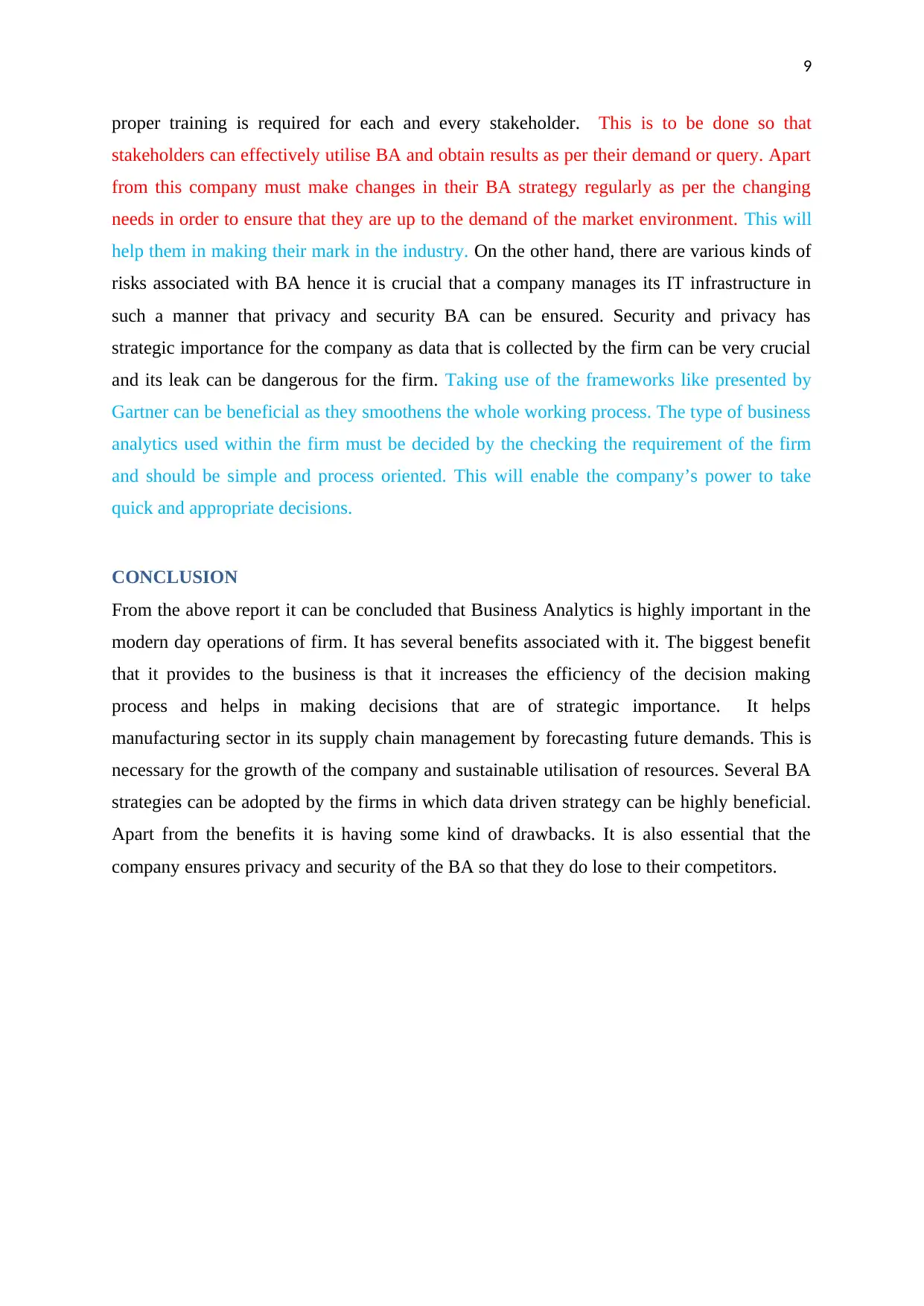
9
proper training is required for each and every stakeholder. This is to be done so that
stakeholders can effectively utilise BA and obtain results as per their demand or query. Apart
from this company must make changes in their BA strategy regularly as per the changing
needs in order to ensure that they are up to the demand of the market environment. This will
help them in making their mark in the industry. On the other hand, there are various kinds of
risks associated with BA hence it is crucial that a company manages its IT infrastructure in
such a manner that privacy and security BA can be ensured. Security and privacy has
strategic importance for the company as data that is collected by the firm can be very crucial
and its leak can be dangerous for the firm. Taking use of the frameworks like presented by
Gartner can be beneficial as they smoothens the whole working process. The type of business
analytics used within the firm must be decided by the checking the requirement of the firm
and should be simple and process oriented. This will enable the company’s power to take
quick and appropriate decisions.
CONCLUSION
From the above report it can be concluded that Business Analytics is highly important in the
modern day operations of firm. It has several benefits associated with it. The biggest benefit
that it provides to the business is that it increases the efficiency of the decision making
process and helps in making decisions that are of strategic importance. It helps
manufacturing sector in its supply chain management by forecasting future demands. This is
necessary for the growth of the company and sustainable utilisation of resources. Several BA
strategies can be adopted by the firms in which data driven strategy can be highly beneficial.
Apart from the benefits it is having some kind of drawbacks. It is also essential that the
company ensures privacy and security of the BA so that they do lose to their competitors.
proper training is required for each and every stakeholder. This is to be done so that
stakeholders can effectively utilise BA and obtain results as per their demand or query. Apart
from this company must make changes in their BA strategy regularly as per the changing
needs in order to ensure that they are up to the demand of the market environment. This will
help them in making their mark in the industry. On the other hand, there are various kinds of
risks associated with BA hence it is crucial that a company manages its IT infrastructure in
such a manner that privacy and security BA can be ensured. Security and privacy has
strategic importance for the company as data that is collected by the firm can be very crucial
and its leak can be dangerous for the firm. Taking use of the frameworks like presented by
Gartner can be beneficial as they smoothens the whole working process. The type of business
analytics used within the firm must be decided by the checking the requirement of the firm
and should be simple and process oriented. This will enable the company’s power to take
quick and appropriate decisions.
CONCLUSION
From the above report it can be concluded that Business Analytics is highly important in the
modern day operations of firm. It has several benefits associated with it. The biggest benefit
that it provides to the business is that it increases the efficiency of the decision making
process and helps in making decisions that are of strategic importance. It helps
manufacturing sector in its supply chain management by forecasting future demands. This is
necessary for the growth of the company and sustainable utilisation of resources. Several BA
strategies can be adopted by the firms in which data driven strategy can be highly beneficial.
Apart from the benefits it is having some kind of drawbacks. It is also essential that the
company ensures privacy and security of the BA so that they do lose to their competitors.
Secure Best Marks with AI Grader
Need help grading? Try our AI Grader for instant feedback on your assignments.

10
REFERENCES
Columbus, L., (2017) Business Analytics is creating a new era of Manufacturing Intelligence.
[Online]. Available at: https://selecthub.com/business-analytics/business-analytics-creating-
new-era-manufacturing-intelligence/. [Accessed on 4 May 2018].
Dubey, R., Gunasekaran, A., Childe, S.J., Wamba, S.F. and Papadopoulos, T., (2016) The
impact of big data on world-class sustainable manufacturing. The International Journal of
Advanced Manufacturing Technology, 84(1-4), pp.631-645.
Dutta, D. and Bose, I., (2015) Managing a big data project: the case of ramco cements
limited. International Journal of Production Economics, 165, pp.293-306.
Evans, J.R. and Lindner, C.H., (2012) Business analytics: the next frontier for decision
sciences. Decision Line, 43(2), pp.4-6.
Hofmann, M. and Klinkenberg, R. eds., (2013) RapidMiner: Data mining use cases and
business analytics applications. CRC Press.
Kasemsap, K., (2015) The role of business analytics in performance management. Handbook
of research on organizational transformations through big data analytics, pp.126-145.
Kumar V., (2014) 12 drivers of big data analytics. [Online]. Available at:
https://analyticsweek.com/content/12-drivers-bigdata-analytics/ . [Accessed on: 4 May 2018].
Minelli, M., Chambers, M. and Dhiraj, A., (2012) Big data, big analytics: emerging business
intelligence and analytic trends for today's businesses. John Wiley & Sons.
Rosich, M., (2017) 4 Pillars of analytics strategies. [Online]. Available at:
https://www.cio.com/article/3221467/analytics/4-pillars-of-analytics-strategies.html.
[Accessed on 4 May 2018].
Seehus, R., (2012) Four key challenges for business analytics. [Online]. Available at:
https://www.capgemini.com/2012/04/four-key-challenges-for-business-analytics/. [Accessed
on 4 May 2018].
REFERENCES
Columbus, L., (2017) Business Analytics is creating a new era of Manufacturing Intelligence.
[Online]. Available at: https://selecthub.com/business-analytics/business-analytics-creating-
new-era-manufacturing-intelligence/. [Accessed on 4 May 2018].
Dubey, R., Gunasekaran, A., Childe, S.J., Wamba, S.F. and Papadopoulos, T., (2016) The
impact of big data on world-class sustainable manufacturing. The International Journal of
Advanced Manufacturing Technology, 84(1-4), pp.631-645.
Dutta, D. and Bose, I., (2015) Managing a big data project: the case of ramco cements
limited. International Journal of Production Economics, 165, pp.293-306.
Evans, J.R. and Lindner, C.H., (2012) Business analytics: the next frontier for decision
sciences. Decision Line, 43(2), pp.4-6.
Hofmann, M. and Klinkenberg, R. eds., (2013) RapidMiner: Data mining use cases and
business analytics applications. CRC Press.
Kasemsap, K., (2015) The role of business analytics in performance management. Handbook
of research on organizational transformations through big data analytics, pp.126-145.
Kumar V., (2014) 12 drivers of big data analytics. [Online]. Available at:
https://analyticsweek.com/content/12-drivers-bigdata-analytics/ . [Accessed on: 4 May 2018].
Minelli, M., Chambers, M. and Dhiraj, A., (2012) Big data, big analytics: emerging business
intelligence and analytic trends for today's businesses. John Wiley & Sons.
Rosich, M., (2017) 4 Pillars of analytics strategies. [Online]. Available at:
https://www.cio.com/article/3221467/analytics/4-pillars-of-analytics-strategies.html.
[Accessed on 4 May 2018].
Seehus, R., (2012) Four key challenges for business analytics. [Online]. Available at:
https://www.capgemini.com/2012/04/four-key-challenges-for-business-analytics/. [Accessed
on 4 May 2018].

11
Stubbs, E., (2011) The value of business analytics: Identifying the path to profitability (Vol.
43). John Wiley & Sons.
Zhong, R.Y., Newman, S.T., Huang, G.Q. and Lan, S., (2016) Big Data for supply chain
management in the service and manufacturing sectors: Challenges, opportunities, and future
perspectives. Computers & Industrial Engineering, 101, pp.572-591.
Stubbs, E., (2011) The value of business analytics: Identifying the path to profitability (Vol.
43). John Wiley & Sons.
Zhong, R.Y., Newman, S.T., Huang, G.Q. and Lan, S., (2016) Big Data for supply chain
management in the service and manufacturing sectors: Challenges, opportunities, and future
perspectives. Computers & Industrial Engineering, 101, pp.572-591.
1 out of 12
Related Documents
Your All-in-One AI-Powered Toolkit for Academic Success.
+13062052269
info@desklib.com
Available 24*7 on WhatsApp / Email
![[object Object]](/_next/static/media/star-bottom.7253800d.svg)
Unlock your academic potential
© 2024 | Zucol Services PVT LTD | All rights reserved.





